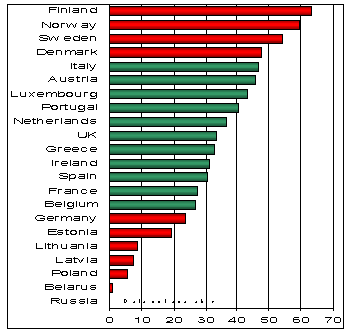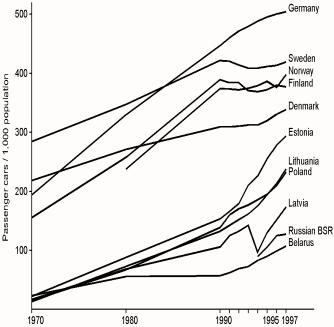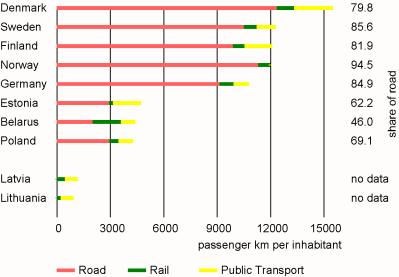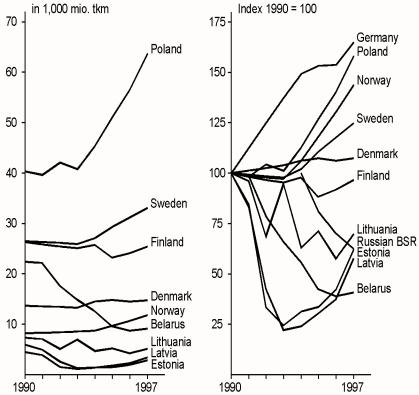1.5 Growing communication intensity
Among the most evident impacts of transition is a growing propensity and ability to communicate, in physical (travel and transport) and in non-physical terms (tele-communication).
Tele-communication
Telephone penetration increased sharply, reaching (year 1997) above 30% in Estonia and Latvia, between 20 and 30% in Belarus and Lithuania, 15-20% in Poland and Russia.
Even more distinct is the rapid market penetration of mobile phones. But there, development is not so different from non-transition countries.
The Nordic countries are world leaders in mobile phone penetration, approaching saturation. Other countries catch up, reducing rapidly presently observed national differences.
|
Mobile phone subscribers/100 inhabitants in selected BSR and other countries, 1999
|

|
|
Source: Mobile communications/ Nordregio
EU & EEA countries: 1.10.99, transition countries: 1.4.99
|
As regards Internet usage, Estonia is high on the list. Again, market penetration proceeds very fast, reducing current differences.
Passenger travelling
Non-physical communication has so far not led to a substitution of physical travelling. This is clearly linked with the availability of private cars.
Car availability in the BSR countries is steadily growing, though with different dynamics in different parts of the BSR. Three groups of countries can be distinguished: the north-western countries and two groups of transition countries.
|
Car ownership rates*) in BSR countries, 1970-1997
*) no. of passenger cars per 1,000 population
|

|
|
Source: European Commission (2000), National Statistics/ Nordregio
|
Already in 1970, north-western countries had car-ownership rates of between 200 and 300. High growth rates were noted in the 1970s and 1980s, after which the Nordic countries Sweden, Norway and Finland seem to have reached saturation. Since 1990, Sweden's car ownership rate is about 400. Norway and Finland were slightly below. In Germany, having reached 500, growth in car ownership continued in the 1990s, accelerated by new Länder catching up.
A second group formed by Poland and the Baltic states showed in 1970 a car ownership rate of just 20, reaching about 100 by 1990. Then, a dramatic rise started, with Estonia at the top to reach 300 in less than ten years. In Lithuania and Poland, 1997 rates were about 240, in Latvia still below 200. High growth rates continued till now, and Estonia has already reached the 'Nordic' motorisation level.
The third group consists of Belarus and the Russian BSR. They experienced a similar development path as the previous group during the 1970s and 1980s. But during the last decade, growth was much slower leading to rates of 130 in the Russian BSR and 120 in Belarus (1997).
Differences in car ownership largely explain differences in the propensity to travel. Denmark shows the highest propensity with more than 15,000 passenger-km per year (approx. 12,000 in other W-BSR countries).
|
Passenger traffic volumes in BSR countries per capita per year
|

|
|
Sources: CEI (1999); European Commission (2000); National Statistics/ Nordregio.
|
Substantially lower per capita passenger traffic exists in the transition countries, with 4,000 to 5,000 pass.-km per year. This indicates the potential - and threat - for further growth still tending overwhelmingly to be on roads.
|
Goods transport on roads in BSR countries, 1990 - 1997
|

|
|
Source: European Commission, 2000; National Statistics. Note: Russian BSR except Kaliningrad region, Russian BSR index is based on tons carried, 1994 = 100/ Nordregio
|
Freight
A different situation exists in goods transport. The amount of goods transport per 1,000 of GNP is significantly lower in high-income countries. This is largely due to different structure of the economies (higher share of services sector and of high-value production).
Existing forecasts indicate that growth in national production will be higher than reductions in transport volumes per unit of GNP. As in passenger transport, if western experience will be repeated, any subsequent growth in transport demand tends to go to road.

